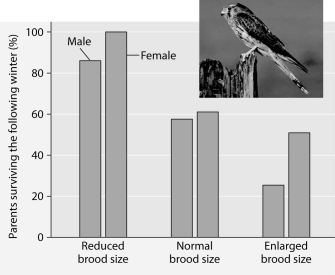Multiple Choice
Please read the paragraph below and review Figure 53.2 to answer the following question.
Researchers in the Netherlands studied the effects of parental care given in European kestrels over five years. The researchers transferred chicks among nests to produce reduced broods (three or four chicks) , normal broods (five or six chicks) , and enlarged broods (seven or eight chicks) . They then measured the percentage of male and female parent birds that survived the following winter. (Both males and females provide care for chicks.)

Figure 53.2: Brood size manipulations in the kestrel: Effects on offspring and parent survival.
-Which of the following is a conclusion that can be drawn from this graph?
A) Female survivability is more negatively affected by larger brood size than is male survivability.
B) Male survivability decreased by 50% between reduced and enlarged brood treatments.
C) Both males and females had increases in daily hunting with the enlarged brood size.
D) There appears to be a negative correlation between brood enlargements and parental survival.
E) Chicks in reduced brood treatment received more food, weight gain, and reduced mortality.
Correct Answer:

Verified
Correct Answer:
Verified
Q39: The Allee effect is used to describe
Q40: Why do populations grow more slowly as
Q41: Use the survivorship curves in Figure 53.1
Q42: During exponential growth, a population always<br>A) grows
Q43: According to the logistic growth equation<br><img src="https://d2lvgg3v3hfg70.cloudfront.net/TB5463/.jpg"
Q45: Natural selection involves energetic trade-offs between<br>A) choosing
Q46: Which of the following statements about human
Q47: Logistic growth of a population is represented
Q48: Pacific salmon and annual plants are excellent
Q49: Which of the following causes populations to